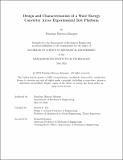| dc.contributor.advisor | Yue, Dick K.P. | |
| dc.contributor.author | Herrero-Marques, Penelope | |
| dc.date.accessioned | 2024-09-03T21:14:55Z | |
| dc.date.available | 2024-09-03T21:14:55Z | |
| dc.date.issued | 2024-05 | |
| dc.date.submitted | 2024-07-10T17:33:29.002Z | |
| dc.identifier.uri | https://hdl.handle.net/1721.1/156654 | |
| dc.description.abstract | Wave energy is a promising source of renewable energy that has the potential to play a significant role in the global transition towards sustainable energy. Unlike other forms of renewable energy, wave energy is not dependent on weather patterns or daylight hours, making it a reliable and consistent source of energy. As the demand for clean energy continues to grow, wave energy can provide a valuable contribution to the global energy mix, helping to reduce greenhouse gas emissions and mitigate the negative impacts of climate change. Wave energy is harvested by wave energy converters—devices that convert the kinetic energy of ocean waves into electrical energy. Wave energy converter (WEC) arrays consist of multiple individual WEC devices that are arranged in a specific pattern. The arrangement of the devices within the array is designed to optimize their performance and reduce their negative effects on the surrounding environment. Developing reliable models of WEC array performance and optimal array configurations is critical to advancing research in this exciting field. This thesis details the design and validation of a test rig for experimentally testing wave energy converter array performance in the MIT Building 48 tow tank. The test rig features a novel magnetic damper that was designed and characterized to uniquely suit the conditions of the tow tank. The final test rig is capable of measuring the power captured by oscillating buoys as a function buoy shape, mass, and damping provided. Beyond facilitating hydrodynamics research, the test platform will be a valuable educational resource for classes such as Hydrodynamics that incorporate laboratory components. Its functionality will allow students to explore firsthand the principles of wave energy conversion, buoy dynamics, and the impact of various design parameters on energy capture. By providing hands-on experience, the test rig will enhance learning outcomes and cultivate a deeper understanding of renewable ocean energy technologies.Wave energy is a promising source of renewable energy that has the potential to play a significant role in the global transition towards sustainable energy. Unlike other forms of renewable energy, wave energy is not dependent on weather patterns or daylight hours, making it a reliable and consistent source of energy. As the demand for clean energy continues to grow, wave energy can provide a valuable contribution to the global energy mix, helping to reduce greenhouse gas emissions and mitigate the negative impacts of climate change. Wave energy is harvested by wave energy converters—devices that convert the kinetic energy of ocean waves into electrical energy. Wave energy converter (WEC) arrays consist of multiple individual WEC devices that are arranged in a specific pattern. The arrangement of the devices within the array is designed to optimize their performance and reduce their negative effects on the surrounding environment. Developing reliable models of WEC array performance and optimal array configurations is critical to advancing research in this exciting field. This thesis details the design and validation of a test rig for experimentally testing wave energy converter array performance in the MIT Building 48 tow tank. The test rig features a novel magnetic damper that was designed and characterized to uniquely suit the conditions of the tow tank. The final test rig is capable of measuring the power captured by oscillating buoys as a function buoy shape, mass, and damping provided. Beyond facilitating hydrodynamics research, the test platform will be a valuable educational resource for classes such as Hydrodynamics that incorporate laboratory components. Its functionality will allow students to explore firsthand the principles of wave energy conversion, buoy dynamics, and the impact of various design parameters on energy capture. By providing hands-on experience, the test rig will enhance learning outcomes and cultivate a deeper understanding of renewable ocean energy technologies. | |
| dc.publisher | Massachusetts Institute of Technology | |
| dc.rights | In Copyright - Educational Use Permitted | |
| dc.rights | Copyright retained by author(s) | |
| dc.rights.uri | https://rightsstatements.org/page/InC-EDU/1.0/ | |
| dc.title | Design and Characterization of a Wave Energy Converter Array Experimental Test Platform | |
| dc.type | Thesis | |
| dc.description.degree | S.B. | |
| dc.contributor.department | Massachusetts Institute of Technology. Department of Mechanical Engineering | |
| mit.thesis.degree | Bachelor | |
| thesis.degree.name | Bachelor of Science in Mechanical Engineering | |
